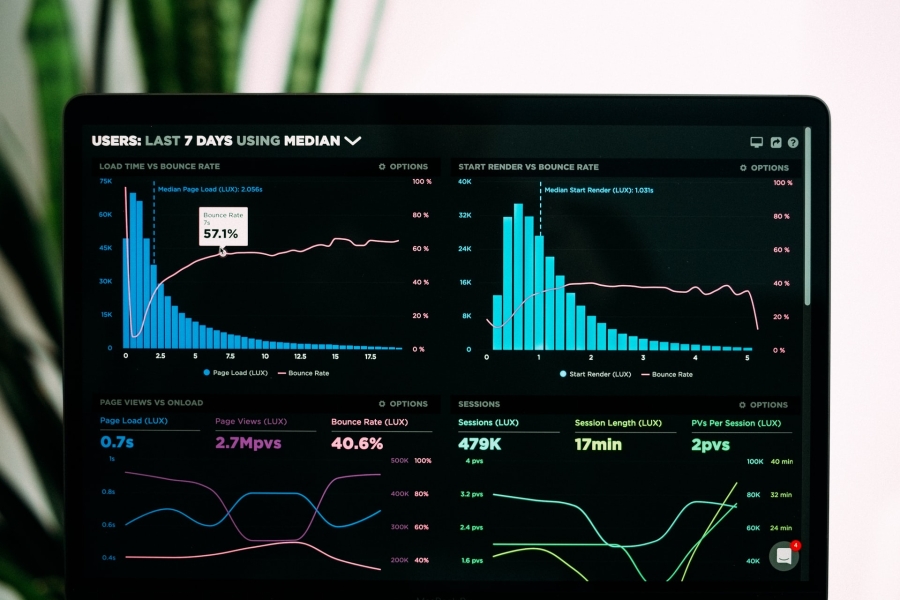The fitness industry continues to go from strength to strength. After surviving the worst of the COVID-19 pandemic, many gym owners are looking to capitalize on people's renewed energy for working out. And it's little surprise, given the global fitness industry will be worth close to $100 billion in 2022.
Gym owners need to be aware of the key metrics that make their businesses successful and profitable. Key metrics or key performance indicators (KPIs) are something that every gym or fitness studio owner should be using to keep tabs on their business. In this article, we will explain what key metrics are and how they can be used to benefit your business.
We'll also cover:
- What is a key performance indicator (KPI)?
- Why key metrics are important for your business
- Key metrics to track as a gym owner
Let's begin!
Source: Unsplash
What is a key performance indicator (KPI)?
KPI stands for key performance indicator, a quantifiable measure of performance over time for a specific objective. KPIs provide a set of targets to aim for, progress to keep track of and offer insights that assist people across the business to make better decisions.
Key performance indicators are used across all forms of business, including fitness. KPIs provide insights into all areas of your business, such as marketing, sales, customer relations, and many more. Examples of particular KPIs include:
- Member retention
- Churn rate
- Attendance rates
- Employee satisfaction
- Customer reviews
It's important to remember that the more defined you are with KPIs, the more efficient they can be to your business. Valuable metrics should be highly defined and specific. These highly defined metrics will help you make more informed business decisions relating to all facets of your gym. Setting these metrics can streamline basic business functions by identifying and capitalizing on what is working for your gym.
Why key metrics are important for your business
There are several factors that make owning a gym or fitness studio unique. For starters, gyms can be completely unpredictable due to the underlying business structure. Almost all gyms operate on a subscription basis that can be canceled at any time. This setup makes it difficult to predict how many paying customers there will be at a given moment.
Utilizing the numbers and figures makes it easier to understand what is and isn't working. KPIs help business owners garner a better understanding of the different approaches proven to be successful. This notion spreads across the entire business. For example, the costs of running a gym are increasing every year. The rise in prices is felt across the entire business, from equipment costs and rent to staffing and salaries. And that's not even considering the difficulty that the COVID-19 pandemic has had on the entire industry over the past two years.
All gym owners are feeling the pinch. This sentiment spans from mega-chains down to single facility operations. The complicated business climate we live in makes it even more critical to measure and understand key metrics accurately. The knowledge obtained by KPIs will help shape critical business decisions across the entire organization. Key metrics assist in demonstrating and utilizing what's profitable so you can use this cash flow more widely across the entire business.
Key metrics also help you plan for the future. Rather than being passive, key metrics provide clear cut insights that allow you to be proactive when something isn't working. As a gym owner, you need to stay one step ahead and have contingency plans when things aren't at their best. By tracking key metrics regularly, you can accurately predict any shortfall or potential problems with confidence. In doing so, you will not only stay one step ahead of any drama but also stay ahead of your fiercest competition.
Source: Unsplash
Key metrics to track as a gym owner
This section will look at the most important key metrics you should track as a gym owner. There are several to cover, so we've broken them down into five key categories to make things a little easier.
PerfectGym provides an all-in-one CRM where you can easily track important key metrics for your business.
Now, let's take a look at the most important key metrics for your business to track!
Operational
Operational metrics refer to all things concerning the running of your business. By tracking these metrics, you will help keep operations streamlined and profitable.
Lifetime Value of a Customer (LTV)
LTV measures the total revenue that your business can expect to generate from a single customer. This metric can be challenging to get to an exact number; however, it is good to have an approximate idea. Keeping track of customer lifetime value will help you determine how much you can spend on marketing activities and forecasting revenue for the year ahead.
Return on investment (ROI)
ROI helps you determine the amount of money you spend in relation to how much money you earn. The return on investment metric can be in many different areas of your business. For instance, you can calculate the ROI on a marketing campaign based on the marketing budget vs the amount of new business that particular campaign generated.
Customer Acquisition Cost (CAC)
The customer acquisition cost KPI refers to the total spend on sales and marketing to acquire new customers to your gym. The CAC metric is often used in conjunction with LTV to measure the value generated by a new customer.
Net customer worth
Once you've calculated LTV and CAC, you can subtract the customer acquisition cost from the customer's lifetime value to determine net customer worth. This key metric is the revenue your business earns from each client after taking the marketing costs into account.
Performance
Performance-based KPIs offer insights into the overall performance of your gym. These metrics are commonly applied to sales and marketing, however, but can also be used to determine performance in other areas such as classes or counting inventory. Here are the most popular performance KPIs:
Website traffic
Website traffic is simply the total number of users visiting your website at a given moment. Every modern gym owner needs to be tracking website traffic. It doesn't matter how good your marketing skills are, be it via social media, email, video - whatever. It will be all for nothing if no one ends up visiting your website.
Conversion Rate (CVR)
Conversion is often used to determine the success of marketing campaigns and helps in calculating ROI. This KPI measures the percentage of people who took a desired action, for instance, registering for your newsletter or clicking on a link that redirects to another landing page on your site.
Class attendance rate
Classes are an excellent stream of revenue but quickly become costly if they are constantly empty or being canceled. For this reason, you need to pay close attention to class attendance rates.
Source: Unsplash
Marketing
Marketing KPIs are crucial to track to measure the success of your marketing campaigns. Here are our top marketing key metrics.
Email open rate
Email open rate is the percentage of people that open an email sent for a particular email blast or campaign. This key metric is important to track to understand better how well participants are receiving your email message. For instance, if you notice a low open rate, you should consider a different subject line to gain better attention in the recipient's inbox.
With PerfectGym Marketing Automation, you can craft smart email campaigns and measure important key metrics such as email open rate.
Click-through rate (CTR)
Click-through rate (CTR) refers to the number of people that click through your online ads. A high CTR indicates that your ad copy and message resonate with your audience. If you notice that one of your ads is getting a higher click-through rate, you should consider reallocating your budget to the higher-performing ad.
Unsubscribe rate
The unsubscribe rate is the percentage of people who unsubscribe to your newsletter. A high unsubscribe rate can be concerning because you are losing the opportunity to contact your customers (both potential and existing). With that said, sometimes people unsubscribe from emails just because they are annoying and fill their inbox, so you shouldn't place as much emphasis on this metric compared to others.
Social media
Social media is a powerful tool for reaching new audiences and driving your branding and messaging home. There are several social media metrics that you can track; however, some of the most important to measure are number of likes, reshares, and number of followers. Building a healthy social media audience is important to build trust in your gym and reach new clients.
Marketing qualified leads (MQL)
Marketing qualified leads (MQL) refer to a lead who has indicated an interest in what your business has to offer based on marketing efforts. It is essential to build as many MQLs as possible from different marketing campaigns so that these leads can be passed on to your sales team for qualification into an opportunity.
Source: Unsplash
Financial
Financial metrics help you make more informed financial decisions. Keeping track of these key financial metrics will minimize the potential for losses and maximize profits.
Gross revenue
Gross revenue, also known as gross income, is the sum of all money generated by your business without factoring in any costs. In other words, it is the total amount of money earned without deducting any expenses. Gross revenue is vital to track; however, it can be misleading on how well your business is performing. For this reason, a better metric to track for financial purposes is net profit.
Net profit
Net profit refers to your income after all expenses and taxes are paid. This key metric is the most telling of how well your gym is performing financially. Maintaining a healthy level of net profit is crucial for long-lasting success.
Sales qualified leads (SQL)
A sales qualified lead (SQL) is a prospective customer who has moved through the sales pipeline from a marketing qualified lead (MQL). Essentially, an SQL is anyone who has been vetted by a sales representative so that they can now work on turning them into a paying customer.
HR
We've covered all operational, marketing, financial, and sales key metrics. Now it is time to explore our last category, HR. Your gym simply could not run without its employees. HR metrics are some of the most important to keep track of if you want to ensure that your business runs smoothly.
New hire turnover
New hire turnover refers to the number of employees that leave within a given time. To calculate this metric, you first need to assign a given time period - say six months. Then, divide the number of separations in that period by the average number of employees in the same period and multiply by 100.
Employee satisfaction
Employee satisfaction is a critical HR metric to keep tabs on. You can calculate employee satisfaction in several ways; however, one of the most effective is to have all of your employees fill out an anonymous survey. Within the survey, you can ask a series of questions to determine their satisfaction level and assign a score to each employee.
Revenue per employee
Revenue per employee simply refers to the amount of money each employee generates. This metric is important because it is good to keep tabs on your best-performing employees for promotions. Also, you can incentivize your employees with a reward for the highest-earning employee. This reward will motivate your team and deliver better results for your gym.
Source: Pexels
Summing up
Key metrics are critical to track for any gym owner. These metrics help you to see what is working so that you can double down and boost profits. At the same time, key metrics also help you identify weak points in your business that you need to address. By tracking important key metrics in the five categories we discussed in this article, you will get more meaningful results at your gym.
Get in touch with us if you would like to learn more about the PerfectGym CRM or check out some of our other resources for further reading.










